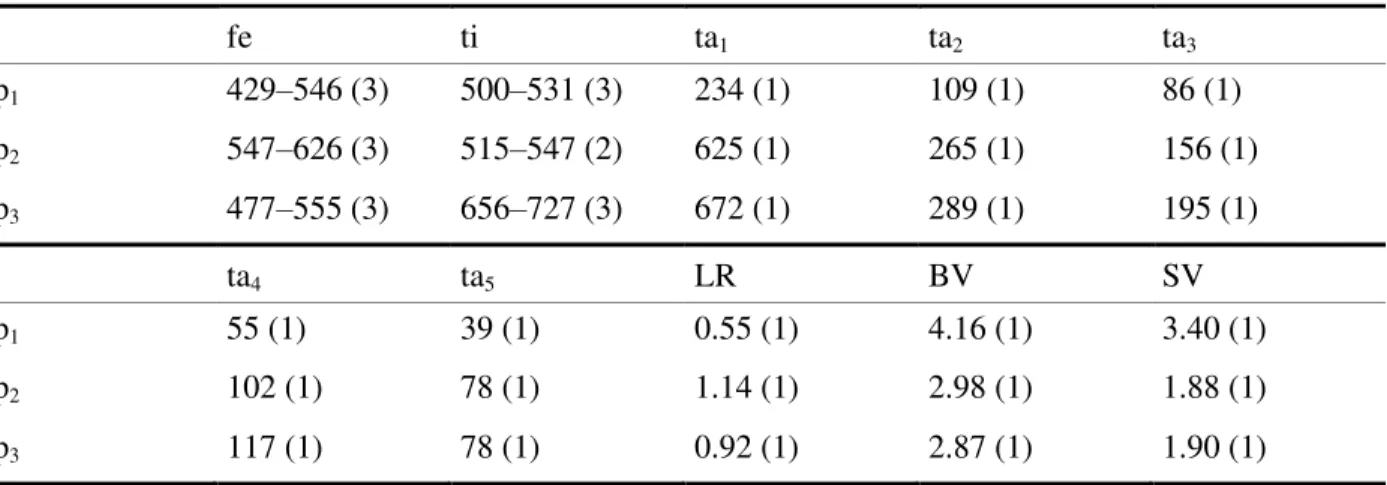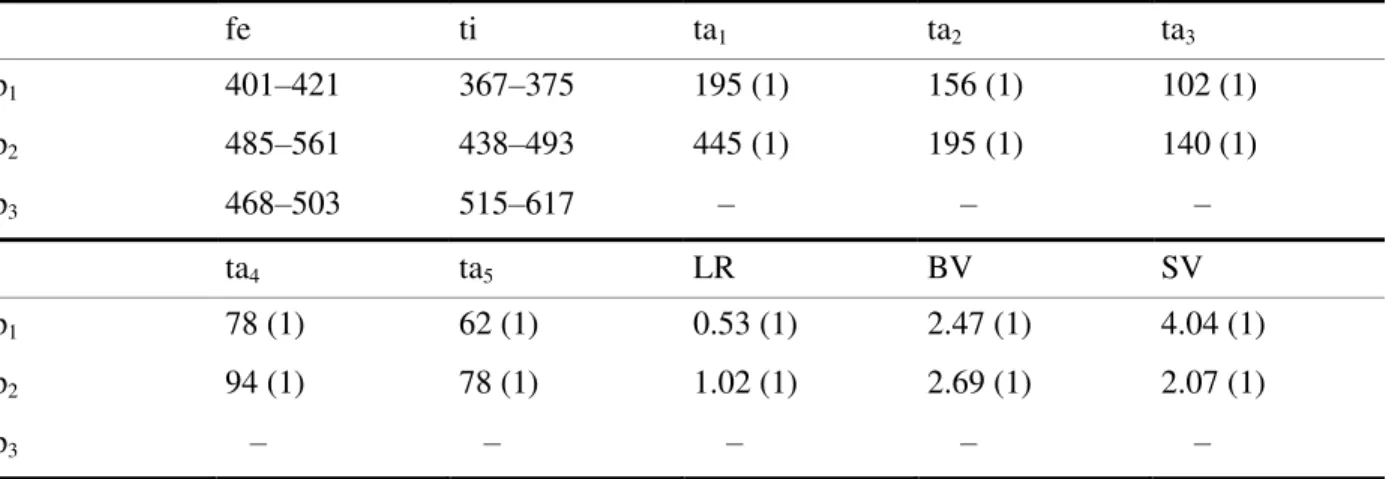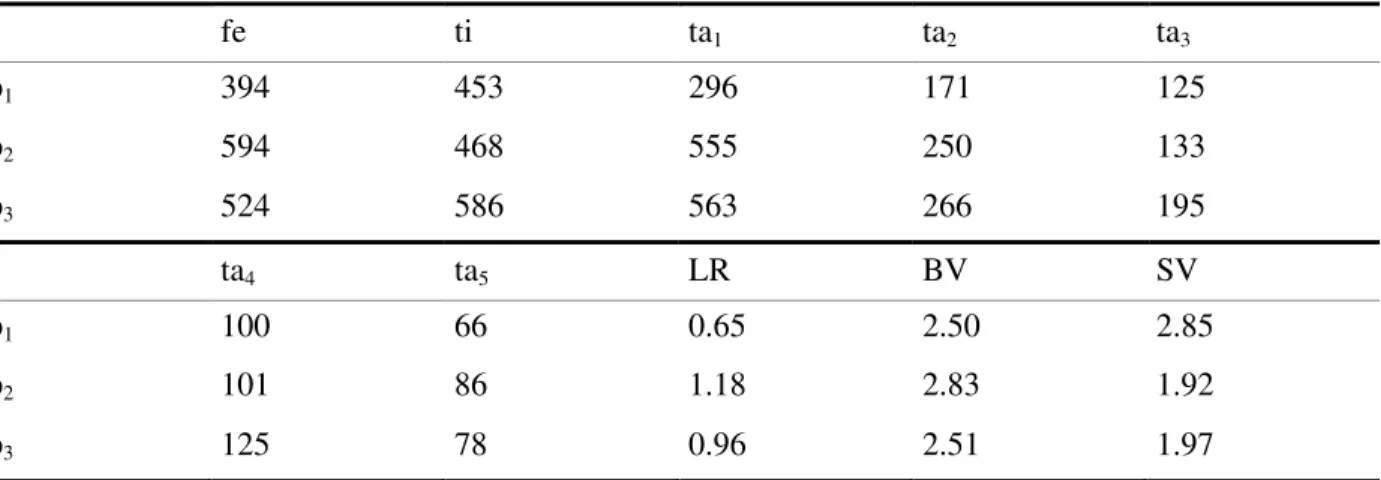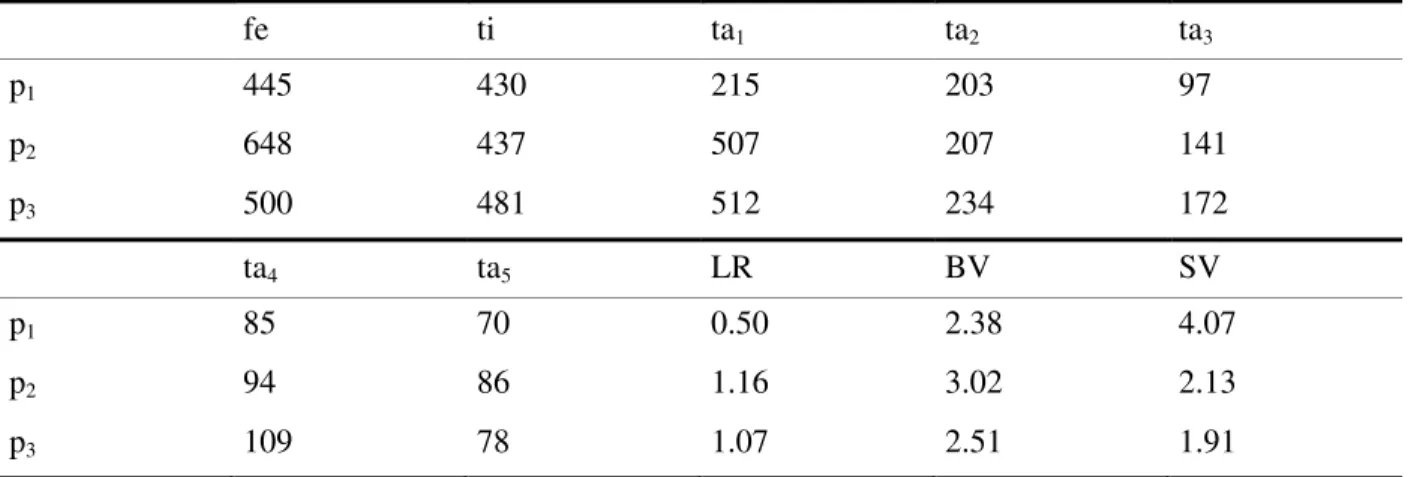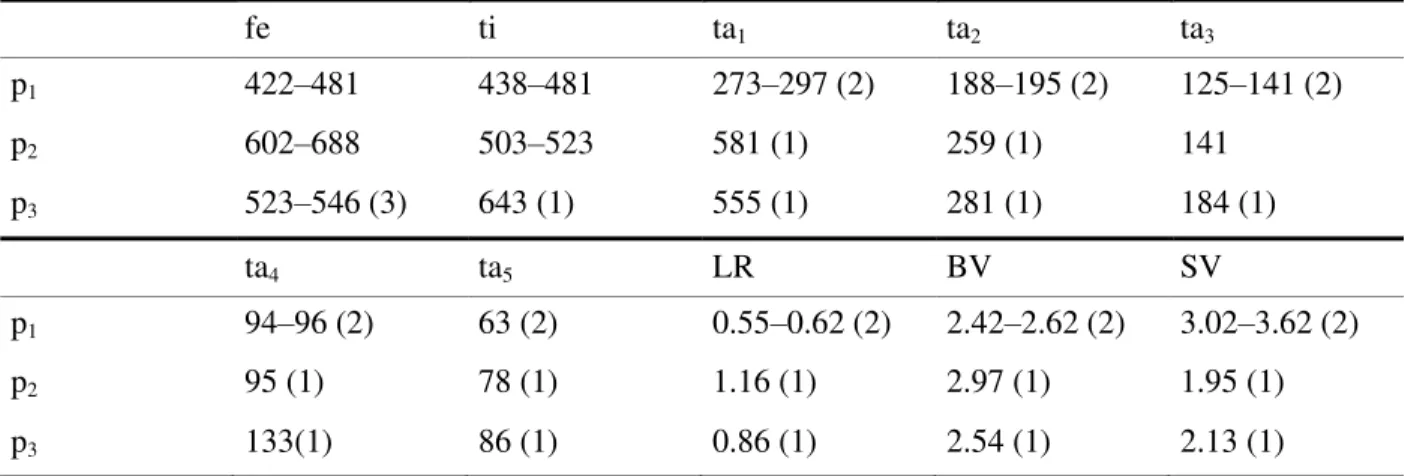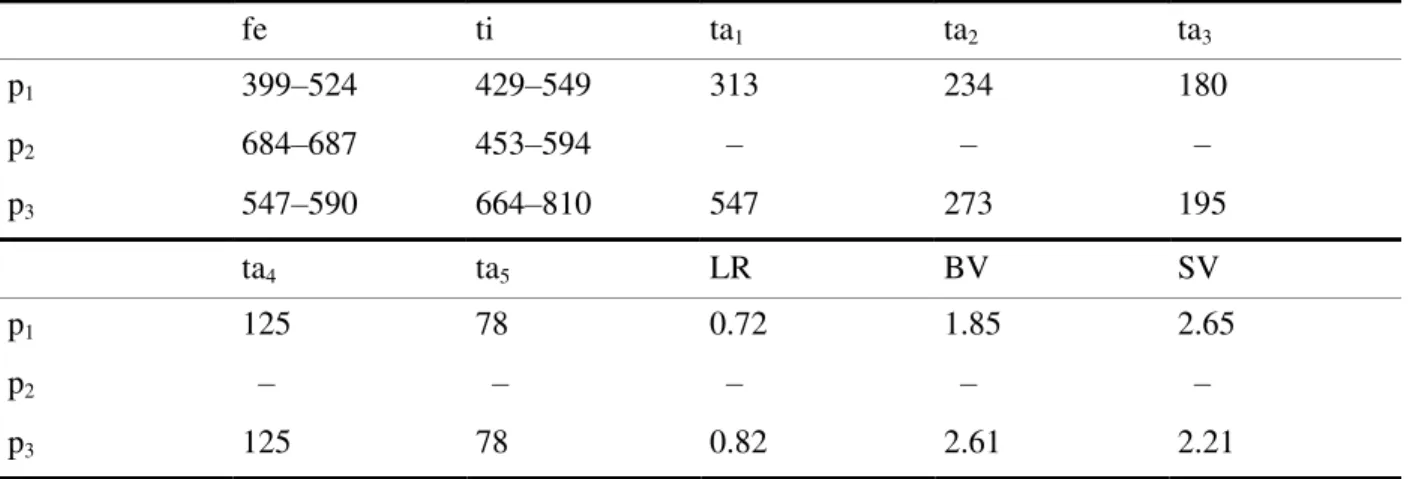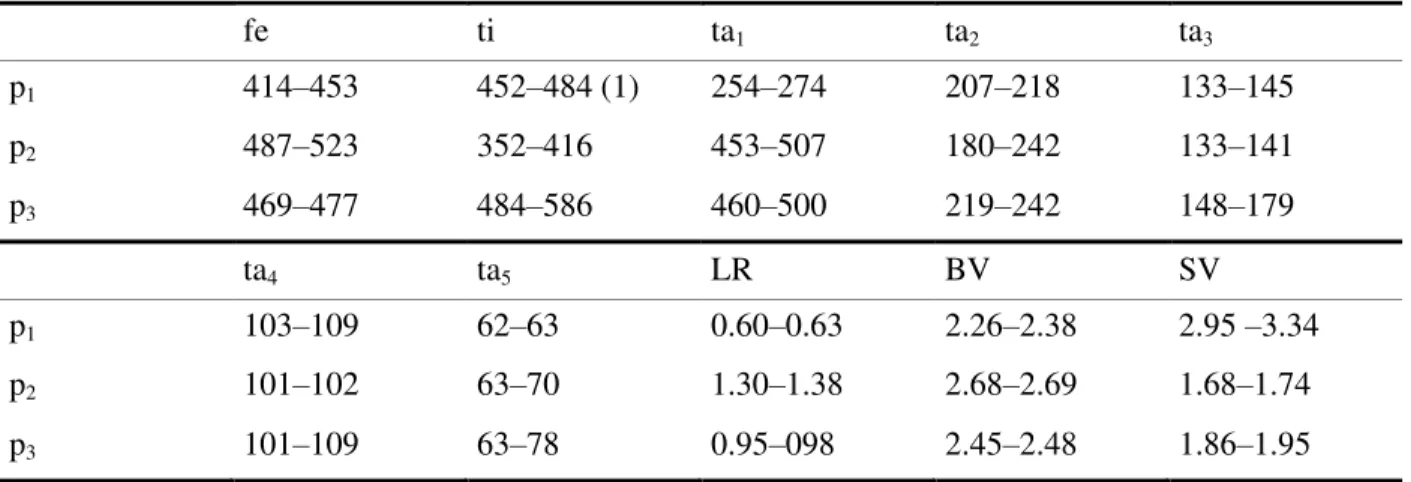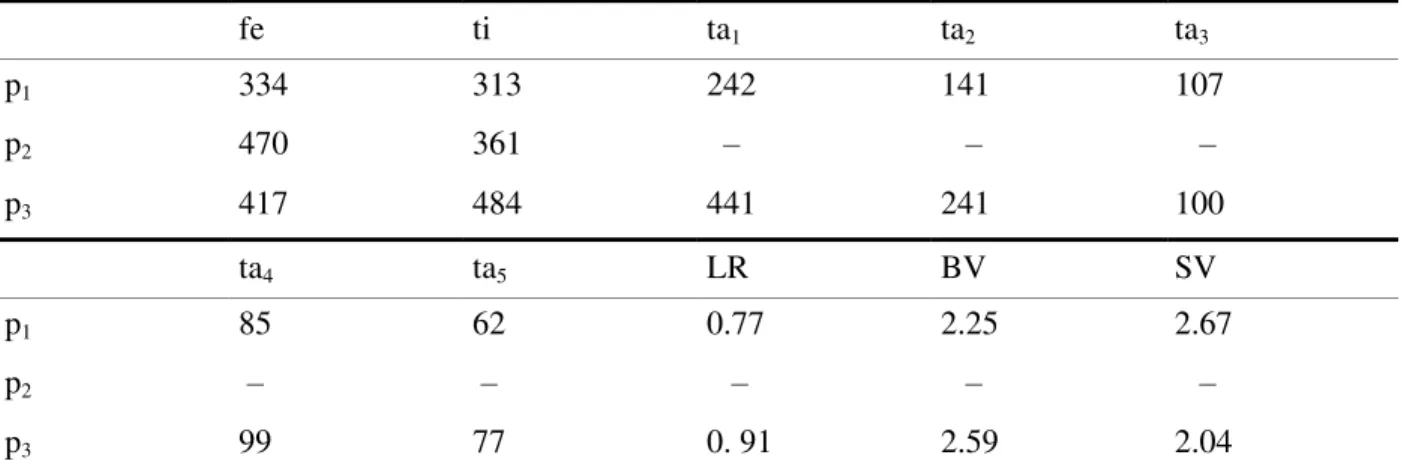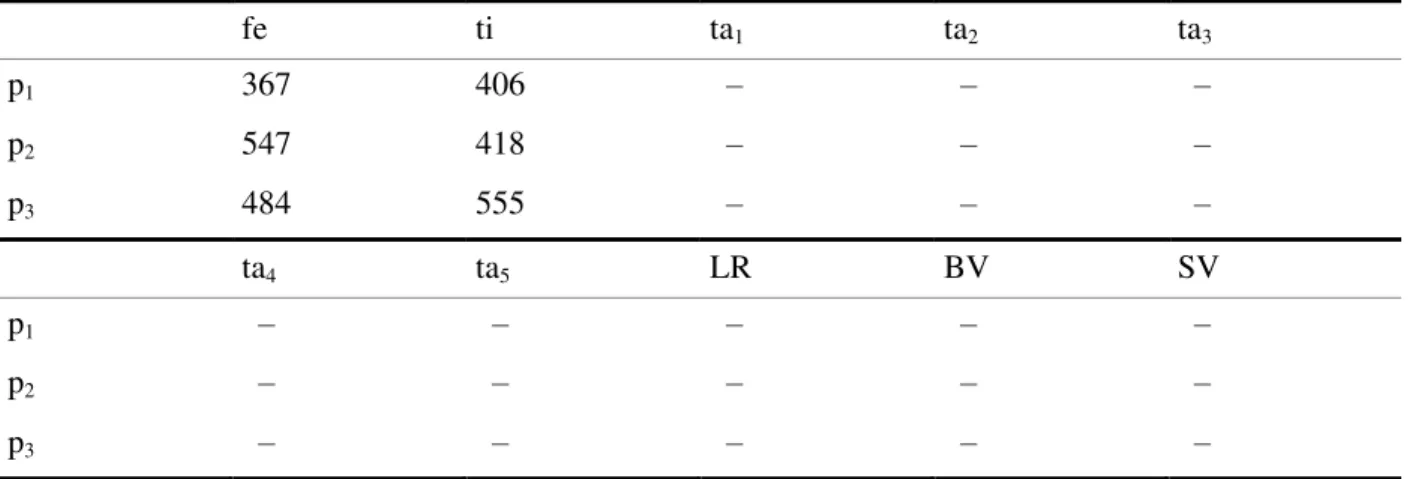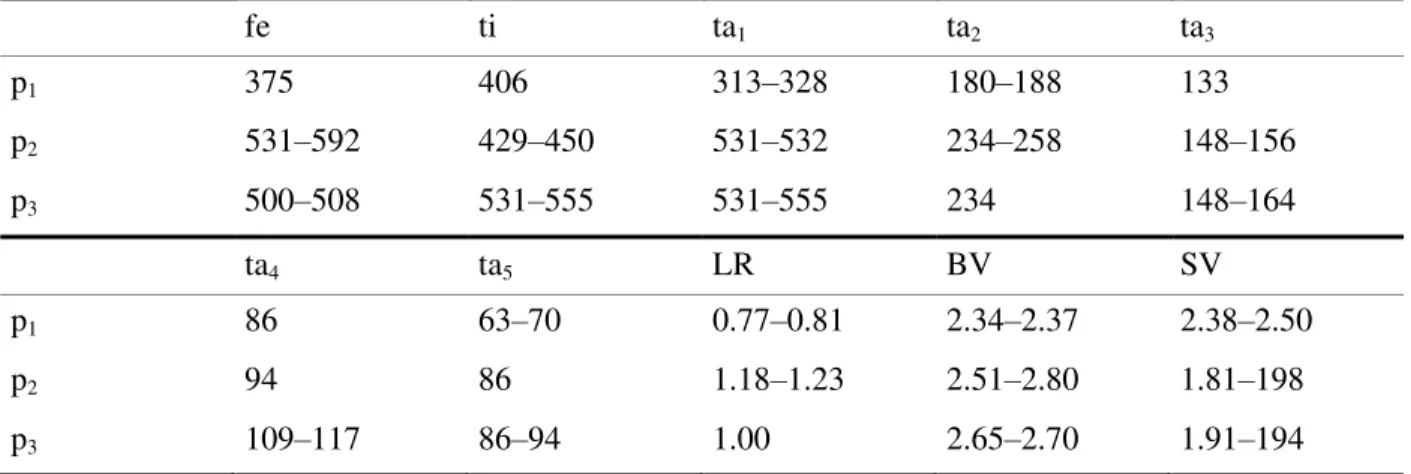Universidade Federal de São Carlos
Centro de Ciências Biológicas e da Saúde
Programa de Pós-Graduação em Ecologia e Recursos Naturais
Sistemática e biogeografia de
Labrundinia
Fittkau, 1962 (Diptera:
Chironomidae: Tanypodinae): uma abordagem morfológica e
molecular
Candidato: Fabio Laurindo da Silva
Orientadora: Profa. Dra. Alaide A. Fonseca Gessner
Universidade Federal de São Carlos
Universidade Federal de São Carlos
Centro de Ciências Biológicas e da Saúde
Programa de Pós-Graduação em Ecologia e Recursos Naturais
Sistemática e biogeografia de
Labrundinia
Fittkau, 1962 (Diptera:
Chironomidae: Tanypodinae): uma abordagem morfológica e
molecular
Fabio Laurindo da Silva
São Carlos - SP
2012Ficha catalográfica elaborada pelo DePT da Biblioteca Comunitária/UFSCar
S586sb
Silva, Fabio Laurindo da.
Sistemática e biogeografia de Labrundinia Fittkau, 1962
(Diptera: Chironomidae : Tanypodinae): uma abordagem morfológica e molecular / Fabio Laurindo da Silva. -- São Carlos : UFSCar, 2013.
283 f.
Tese (Doutorado) -- Universidade Federal de São Carlos, 2012.
1. Insetos aquáticos. 2. Larva. 3. Pupa. 4. Adulto. 5. Taxonomia. 6. Região neotropical. I. Título.
“When you have eliminated all which is impossible, then whatever remains, however improbable, must be the truth”
Doyle, Arthur Conan
“It is good to have an end to journey toward, but it is the journey that matters, in the end”
Este trabalho é dedicado a elas, as pequenas
Labrundínias que, apesar de sua vida efêmera e
discreta, instruíram-me e levaram a terras
A
GRADECIMENTOSAos meus orientadores, Alaide A. Fonseca Gessner e Torbjørn Ekrem, os ensinamentos e o incentivo durante todo meu doutorado.
Às professoras Sonia Silveira Ruiz e Susana Trivinho Strixino a amizade e as oportunidades. Às amigas e parceiras de trabalho Sofia Wiedenbrug e Caroline Silva Neubern de Oliveira. À Elisabeth Stur a calorosa recepção na Noruega.
Aos colegas de laboratório Sondre Dahle, Alyssa Anderson, Ingeborg Engh e Magni Olsen Kyrkjeeide. Aos amigos Alexey, Ana Paula, Andrea, Amanda, Ariano, Carolina, Clóvis, Eduardo, Ellen, Fabio Roque, Gisele, Ivy, Ira, Janda, Juliano, Kogilam, Lurdinha, Paula (a Filhona), Patrícia, Priscila, Magda, Manuel, Marion, Mateus, Nathan (for everything), Neusa, Roberta, Virginia e Wânia.
Aos pesquisadores Augusto Siri, Broughton Caldwell, Charles Watson e John Epler o empréstimo de material.
R
ESUMOEsta pesquisa de doutorado enfocou a sistemática e a biogeografia das espécies de Labrundinia (Diptera: Chironomidae: Tanypodinae), sendo que a base deste estudo incidiu no exame do material-tipo de todas as espécies descritas para o gênero, incluindo espécies depositadas em coleções nacionais e estrangeiras. Adicionalmente, trabalho de campo foi realizado com objetivo de coletar novas espécies e garantir associações seguras entre larvas, pupas e adultos. Neste estudo, foram redescritas 14 espécies conhecidas de Labrundinia e 25 espécies novas para a ciência foram descritas para região Neotropical. Dados morfológicos e moleculares foram utilizados para inferir relações filogenéticas entre espécies do gênero e chaves de identificação foram preparadas para os adultos machos, pupas e larvas. Com base nos resultados da filogenia e distribuição das espécies, análises biogeográficas foram conduzidas na tentativa de determinar a mais provável história biogeográfica para o grupo. As interpretações das análises filogenéticas indicam o gênero Labrundinia como um grupo monofilético, com presença em todas as árvores resultantes. Com base nestas reconstruções filogenéticas, análises biogeográficas foram processadas e indicam que o ancestral de Labrundinia teve diversificação inicial na Região Neotropical.
A
BSTRACTThis doctoral research focused on the systematics and biogeography of the Labrundinia species (Insecta: Diptera: Chironomidae: Tanypodinae). The basis of this study rested on the examination of the type material of all previously described Labrundinia species, including species deposited in national and foreign museums. Field work were carried out to collect more specimens and to secure associations between larvae, pupae and adults. In this study 14 known species of Labrundinia were redescribed and 25 new species were described from the Neotropical region. Morphological and molecular analyses were conducted to infer phylogenetic relationships among all species of the genus and identification keys were developed for all life stages. Based on the results of the phylogeny and distribution of the species, a biogeographic analysis was performed to provide the most probable biogeographic history for the group. The interpretations of the phylogenetic results indicate Labrundinia as a monophyletic group. The group is shown in all resulting trees. Based on these phylogenetic reconstructions, biogeographical analyses were run and indicated Labrundiniaancestor as having its initial diversification in the Neotropical region.
S
UMÁRIOIntrodução ... 1
Introdução Geral ... 1
Objetivos... 3
Estrutura da Tese ... 3
Referências ... 3
Capítulo I - A taxonomic revision of genus Labrundinia Fittkau, 1962 (Diptera: Chironomidae: Tanypodinae) ... 7
Introduction ... 7
Material and Methods ... 8
Taxonomy ... 9
Remarks ... 235
References ... 237
Capítulo II - DNA barcodes for species delimitation in Chironomidae (Diptera): a case study on the genus Labrundinia ... 241
Introduction ... 240
Material and Methods ... 242
Results ... 243
Discussion ... 246
Conclusion ... 250
References ... 251
Capítulo III - Phylogeny and biogeography of Labrundinia fittkau, 1962 (Diptera: Chironomidae): evidence from morphological and molecular analyses ... 256
Introduction ... 256
Material and Methods ... 259
Results and Discussion ... 265
References ... 276
Considerações Finais ... 283
1
I
NTRODUÇÃO
I
NTRODUÇÃOG
ERALA família Chironomidae possui distribuição cosmopolita e seus representantes frequentemente dominam as comunidades de insetos aquáticos, tanto em abundância quanto em riqueza de espécies. Suas espécies ocorrem em todos os continentes, incluindo Antártica e Ilhas Oceânicas. Apesar de algumas espécies terem hábitos terrestres, semiterrestres ou semiaquáticos e marinhos, a grande maioria é dulcícola (Oliver 1971, Armitage et. al 1995, Ferrington 2008).
Nas últimas décadas, esse grupo vem sendo amplamente estudado (Sæther 1990, 2000a-b, Adam e Sæther 1999, Boothroyd e Cranston 1999, Ekrem 2003, Stur e Ekrem 2006, Silva et al. 2010, 2012, Oliveira e Silva 2011), sendo que o crescente interesse, em parte, deve-se à importância dos Chironomidae nos ambientes aquáticos (Pinder 1986), na agricultura, particularmente orizicultura (Ferrarese 1993), nos monitoramentos e avaliações ambientais (Rosenberg e Resh 1992, Armitage et al. 1995), nas pesquisas paleoecológicas (Eggermont et. al 2005, Velle et al. 2005, Schmidt et. al 2011) e na saúde pública (Cranston 1995). No Brasil, apesar do crescente número de trabalhos de cunho ecológico e taxonômico envolvendo a fauna bentônica nos últimos anos, permanece a dificuldade de identificação desses organismos. No caso dos Chironomidae, a maioria dos trabalhos reporta apenas o nível taxonômico de gênero, que, em geral, é insuficiente para conclusões ecológicas, taxonômicas, filogenéticas e evolutivas.
2 O gênero Labrundinia (Tanypodinae: Pentaneurini) foi estabelecido por Fittkau, em 1962, com base em Tanypus longipalpis Goetghebuer, e atualmente reúne 14 espécies (Silva et. al 2011). As espécies neotropicais de Labrundinia são oito: L. fera Roback, L. fosteri Roback, L. hirsuta Roback, L. meta Roback, L. opela Roback, L. parabecki Roback e L. tenata Roback, registradas para a Colômbia (Roback 1987); e L. separata Edwards, para a Argentina (Edwards 1931). Na região Neártica ocorrem quatro espécies, L. becki Roback,L. johannseni Beck e Beck, L. neopilosella Beck e Beck e L. virescens Beck e Beck (Roback 1971). L. longipalpis Goetghebuer representa a única espécie holártica (Silva et al. 2011). Além dessas, 25 novas espécies da América do Sul e Central são descritas neste trabalho de doutoramento. Até o presente estudo, nenhuma filogenia ou mesmo hipótese de monofiletismo foi proposta incluindo Labrundinia, assim como toda a subfamília Tanypodinae.
A maioria das descrições de Labrundinia está fundamentada em adultos machos, o que não contempla o reconhecimento das larvas em nível específico. Esta restrição impede o refinamento da resolução taxonômica em trabalhos de cunho ecológico e a sua compreensão em estudos de avaliações ambientais. O gênero Labrundinia ocupa diferentes ambientes aquáticos com características distintas e a identificação das larvas, em nível genérico, é insuficiente para maioria das propostas de biomonitoramento. Identificações, em nível específico, podem ser alcançadas através da criação individual de larvas e a sua associação com adultos machos emergidos (Ekrem et al. 2007). Este procedimento, no entanto, demanda tempo e nem sempre é bem-sucedido para espécies com exigências ambientais particulares. Ainda, o reconhecimento das espécies com base em machos adultos, é dificultado pela similaridade morfológica interespecífica. Neste contexto, o uso de sequências específicas de DNA para a identificação das espécies constitui uma alternativa.
3
O
BJETIVOSNeste estudo, pretendeu-se: (1) revisar as espécies de Labrundinia com base em seus tipos nominais e descrever novas espécies e semaforontes; (2) elaborar chaves de identificação para os diferentes estágios de vida das espécies do gênero; (3) inferir a filogenia entre as espécies de Labrundinia, incluindo os grupos-irmãos postulados, assim como testar o monofiletismo do gênero; (4) apresentar evidências baseadas em dados morfológicos e sequências de genes nucleares e mitocondriais para a construção de uma hipótese filogenética para Labrundinia, e discutir propostas taxonômicas para as espécies do gênero; (5) realizar análises biogeográficas utilizando as metodologias da biogeografia cladística.
E
STRUTUTURA DAT
ESEEsta tese é apresentada em um conjunto de três capítulos indepedentes, redigidos sob a forma de artigos científicos para posterior publicação nos periódicos estrangeiros ZooKeys, Canadian Entomologist e Zoological Journal of the Linnean Society, respectivamente, o que justifica a redação em inglês. O capítulo I inclui a revisão taxônomica do gênero Labrundinia. O capítulo II trata do uso de sequencias de DNA barcode em delimitações de espécies de Chironomidae utilizando o gênero Labrundinia como caso-teste. O capítulo III consiste no estudo filogenético e biogeográfico do gênero Labrundinia a partir de evidências morfológicas e moleculares.
R
EFERÊNCIASAdam, J.I. e Sæther, O.A. 1999. Revision of the genus Nilothauma Kieffer, 1921 (Diptera: Chironomidae). Entomologica Scandinavica Supplement, 56: 1–107.
Armitage, P.D., Cranston, P.S. e Pinder, L.C.V. (Ed.). The Chironomidae: biology and ecology of non-biting midges. London: Chapman & Hall, 1995. 572p.
Ashe, P., Murray, D.A. e Reiss, F. 1987. The zoogeographical distribution of Chironomidae (Insecta: Diptera). Annales de Limnologie, 23: 27–60.
4 Boothroyd, I. e Cranston, P. S. 1999. The ‘Ice worm’ - the immature stages, phylogeny and biology of the glacier midge Zelandochlus (Diptera: Chironomidae). Aquatic Insects, 21: 303–316.
Coffman, W.P. Conclusions. In: Armitage, P.D., Cranston, P.S. e Pinder, L.C V. (Ed.). The Chironomidae: biology and ecology of non-biting midges. London: Chapman & Hall, 1995. p. 436–447. Cranston, P.S. Medical significance. In: Armitage, P.D., Cranston, P. S. e Pinder, L.C.V. (Ed.). The Chironomidae: biology and ecology of non-biting midges. London: Chapman & Hall, 1995. p. 365–384. Edwards, F. W. 1931. Diptera of Patagonia and South Chile II - Chironomidae. Trustees of the British Museum, 5: 233–331.
Eggermont, H., Verschuren, D. e Dumont, H. 2005. Taxonomic diversity and biogeography of Chironomidae (Insecta: Diptera) in lakes of tropical West Africa using subfossil remains extracted from surface sediments. Journal of Biogeography, 32: 1063–1083.
Ekrem, T. 2003. Towards a phylogeny of Tanytarsus van der Wulp (Diptera: Chironomidae). Is morphology alone sufficient to reconstruct the genealogical relationship? Insect Systematics & Evolution, 34: 199–219.
Ekrem, T. e Willassen, E. 2004. Exploring Tanytarsini relationships (Diptera: Chironomidae) using mitochondrial COII gene sequences. Insect systematics & evolution, 35: 263–276.
Ekrem, T., Willassen, E. e Stur, E. 2007. A comprehensive DNA library is essential for identification with DNA barcodes. Molecular Phylogenetics and Evolution, 43(2): 530–542.
Ekrem, T. Willassen, E. e Stur, E. 2010. Phylogenetic utility of five genes for dipteran phylogeny: a test case in the Chironomidae leads to generic synonymies. Molecular Phylogenetics and Evolution, 57(2): 561–571.
Ferrarese, U. 1993. Chironomids of Italian rice fields. Netherlands Journal of Aquatic Ecology, 26: 341– 346.
Ferrington, E.J. 2008. Global diversity of non-biting midges (Chironomidae; Insecta-Diptera) in freshwater. Hydrobiologia, 595: 447–455.
Fittkau, E. J. 1962. Die Tanypodinae (Diptera: Chironomidae): Die Tribus Anatopyniini, Macropelopiini und Pentaneurini. Abhandlungen zur Larvalsystematik der Insekten, 6: 1–453.
5 subunit 1 divergences among closely related species. Proceedings of the Royal Society of London. Series B: Biological Sciences, 27: 96–99.
Moulton, J.K. e Wiegmann, B.M. 2004. Evolution and phylogenetic utility of CAD (rudimentary) among Mesozoic-aged Eremoneuran Diptera. Molecular Phylogenetics and Evolution, 31: 363–378.
Oliver, D.R. 1971. Life history of the Chironomidae. Annual Review of Entomology, 16: 211–230. Oliveira, C.S.N. e Silva F.L. 2011. Two new species of Larsia Fittkau, 1962 (Diptera: Chironomidae: Tanypodinae) from Neotropical Region, with a checklist of Larsia species of the world. Zootaxa, 2786: 27–41.
Pinder, L.C.V. 1986. Biology of freshwater Chironomidae. Annual Review of Entomology, 31:1–23. Roback, S.S. 1971. The adults of the subfamily Tanypodinae (= Pelopiinae) in North America (Diptera: Chironomidae). The Academy of Natural Sciences of Philadelphia 19th and the Parkway Philadelphia, 17: 1–410.
Roback, S.S. 1987. New species of Labrundinia from Colombia (Diptera: Chironomidae: Tanypodinae). Proceedings of the Academy of Natural Sciences of Philadelphia, 139: 211–222.
Roque, F.O. e Trivinho-Strixino, S. 2003. Guassutanypus oliverai, a new genus and species of Macropelopiini from Brazil (Diptera, Chironomidae). Spixiana, 26: 159–164.
Rosenberg, D.M. e Resh, V.H. 1992. Freshwater biomonitoring using individual organisms, populations, and species assemblages of benthic macroinvertebrates. In: Johnson R.K., Wiederholm T. and Rosenberg D.M (Ed.). Freshwater biomonitoring and benthics macroinvertebrates. New York: Chapman & Hall, p. 40–158.
Sæther, O.A. 1990. Midges and the electronic Ouija board. The phylogeny of the Hydrobaenus group (Chironomidae, Diptera) revised. Zeitschrift für Zoologische Systematik und Evolutionsforschung, 28: 107–136.
Sæther, O.A. 2000a. Phylogeny of the subfamilies of Chironomidae (Diptera). Systematic Entomology, 25: 393–403.
Sæther, O.A. 2000b. Zoogeographical patterns in the Chironomidae (Diptera). Verhandlungen der Internationalen Vereinigung für Theoretische und Angewandte Limnologie, 27: 290–302.
6 Schühli, G.S. Carvalho, C.J.B. e Wiegmann, B.M. 2007. Molecular phylogenetics of the Muscidae (Diptera: Calyptratae): new ideas in a congruence context. Invertebrate Systematics, 21: 263–278.
Silva, F.L., Trivinho-Strixino, S. e Oliveira, H.N. 2010. New species of Cryptochironomus Kieffer, 1918 (Diptera: Chironomidae: Chironominae) from Brazil. Zootaxa, 2614: 18–32.
Silva, L.F., Fonseca-Gessner, A.A. e Ekrem, T. 2011. Revision of Labrundiniamaculata Roback, 1971, a new junior synonym of L. longipalpis (Goetghebuer, 1921) (Diptera: Chironomidae: Tanypodinae). Aquatic Insects, 33: 293–303.
Silva, F.L., Wiedenbrug, S., Oliveira, C.S.N., Trivinho-Strixino S. e Pepinelli M. 2012. Two new species of Hudsonimyia Roback, 1979 (Chironomidae: Tanypodinae) from Neotropical Region unveiled by morphology and DNA Barcoding. Journal of Natural History, 46(25–26): 1615–1638.
Stur, E., Fittkau, E.J. e Serrano, M.A.S. 2006. Parapentaneura bentogomensis gen. n., sp. n., a new Tanypodinae (Diptera, Chironomidae) from Brazil. Zootaxa, 1384: 59–68.
Stur, E. e Ekrem, T. 2006. A revision of West Palaearctic species of the Micropsectra atrofasciata species group (Diptera: Chironomidae). Zoological Journal of the Linnean Society, 146: 162– 225.
7
C
APÍTULO
I
A
TAXONOMIC REVISION OF GENUS L
ABRUNDINIA
F
ITTKAU
,
1962
(D
IPTERA
:
C
HIRONOMIDAE
:
T
ANYPODINAE
)
Fabio Laurindo da Silva
1,2, Alaide Aparecida Fonseca-Gessner
1&Torbjørn Ekrem
21
Laboratory of Aquatic Entomology
,
Department of Hydrobiology, Federal University of São
Carlos, P.O. Box 676, 13565-905, São Carlos, SP, Brazil.
2
Section of Natural History, Museum of Natural History and Archaeology, Norwegian University
of Science and Technology, NO-7491, Trondheim, Norway.
E-mail:
fabelha@hotmail.com
A
BSTRACTThe species of the genus Labrundinia (Diptera: Chironomidae: Tanypodinae: Pentaneurini) are revised, described and figured. Keys to known adult males, pupae and larvae are provided. Fourteen previously known species are redescribed, and 25 species from Neotropical region are diagnosed and described as new to science. An emended diagnosis of the genus is presented and morphological differences to closely related species are discussed.
K
EY WORDS: Pentaneurini, non-biting midges, generic diagnosis, keys, taxonomy, immature stages.
I
NTRODUCTION8 O’Connor 2009) recorded 15 valid species. More recently, Labrundinia maculata Roback was placed as a junior synonym of Labrundinia longipalpis (Goetghebuer) (Silva et al. 2011), which decreases the number of valid species within the genus from 15 to 14.
Labrundinia is known from the Neotropical, Nearctic and western Palaearctic regions, with most species found in the Neotropics. The immatures live in a variety of aquatic systems, from small streams and ponds to lakes and bays, where the larvae usually live associated with aquatic macrophytes or marginal vegetation in slow flowing streams or rivers. Labrundinia specimens often have been reported as predators and recorded in many ecological studies (Trivinho-Strixino and Strixino 1993, Aburaya and Callil 2007, Silva and Fonseca-Gessner 2009, Maltchik et al. 2012). A study of the chironomid fauna associated with aquatic macrophytes, in a small reservoir in southeast Brazil, has reported Labrundinia specimens in high abundance associated with Salvinia auriculata rather than Myriophylum aquaticum, which may indicate that larvae of Labrundinia have specific habitat preferences (Dornfeld and Fonseca-Gessner 2005).
Recent collecting in Brazil has revealed numerous new species of Labrundinia, which supplemented by undescribed species from several entomology collections, yielded 25 new species. The main aim of this study was to revise and describe known and previously unknown species in the genus Labrundinia and to present identification keys to adult males, pupae and larvae as well as an emended diagnosis of the genus.
M
ATERIAL ANDM
ETHODS9 Collections holding holotype material studied here: ANSP, Academy of Natural Sciences of Philadelphia; CAS, California Academy of Sciences; CNC, Canadian National Collection, IRSNB, Institut Royal des Sciences Naturelles de Belgique; MZSP, Museu de Zoologia da Universidade de São Paulo; USNM, National Museum of Natural History; ZSM, Zoologische Staatssammlung München.
T
AXONOMYLabrundinia Fittkau
Ablabesmyia Johannsen 1905: 152. Tanypus Malloch 1915: 372. Tanypus Walley 1928: 583. Pentaneura Edwards 1929: 294. Pentaneura Johannsen 1946: 283. Labrundinia Fittkau 1962: 372. Labrundinia Beck and Beck 1966: 337. Labrundinia Roback 1971: 275.
Type species: Tanypus longipalpis Goetghebuer 1921
Other species of genus: Labrundinia becki Roback 1971. L.fera Roback 1987. L. fosteri Roback 1987. L. johannseni Beck and Beck 1966. L. hirsuta Roback 1987. L. longipalpis (Goetghebuer 1921). L. meta Roback 1987. L. neopilosella Beck and Beck 1966. L. opela Roback 1987. L. parabecki Roback 1987. L. pilosella Loew 1866. L. separata Edwards 1931. L. tenata Roback 1987. L. virescens Beck and Beck 1966.
Diagnostic characters
Male. Small to moderate sized, 1.55–3.19 mm, wing length 1.12–2.22 mm. Head with eyes bare, antenna with terminal flagellomere not offset, almost fused to the penultimate flagellomere. Thorax with 26–56 acrostichals, 8–44 dorsocentrals, 5–17 prealars and 5–14 scutellars; anepisternals, preepisternals and postnotals absent.
10 reticulation of respiratory atrium indistinct; external membrane with pale spines; basal lobe wedge-shaped; thoracic comb with 8–13 conical teeth. Abdominal segment I (A I) with scar; shagreen sparse, more conspicuous on AVII–AVIII, basally concentrated; A II may have prominent spines, sometimes with dense multi-branched spines; A VII with 2–4 lateral setae (LS); tergite VIII with projections over base of anal lobe; anal lobe long and narrow, with inner border membranous, slightly concave; macrosetae with adhesive sheaths; male genital sac almost not reaching apex of anal lobe or slightly surpassing it, sometimes reaching much beyond apex of anal lobe.
Larva: Small to moderately sized, head capsule 398–781 μm long. Head evenly coloured, sometimes may have ventral maculation; surface may be smooth or covered with spinules, lateroventral and posteroventral spine groups present or absent. Antennal ration (AR) 1.76–3.22. Mandible strongly curved with distinct or short, subequal teeth. Ligula with 5 teeth, middle tooth usually longer than outer teeth. Paraligula bifid or multitoothed. Posterior parapod with numerous simple claws and a bifid claw with outer tooth shorter than inner tooth; subbasal seta simple or multitoothed at the base; serrated claw present or absent.
Key to adult males of the Labrundinia species
1. Abdomen with pale with brown transverse bands on any tergite (Figs 5L; 10L) ... 2
– Abdomen brown (Figs 1L; 37L) ... 35
2. Tergite II with divided or faint transverse band (Figs 71L; 60L) or wholly pale (Fig. 31L) ... 3
– Tergite II with distinct continuous transverse band (Fig. 19L) ... 16
3. Tergite II with divided or faint transverse band ... 4
– Tergite II wholly pale ... 9
4. Tergite V wholly brown (Fig. 71 L) ... Labrundinia sp. 19 – Tergite V with transverse band (Figs 5L; 62L) ... 5
5. Tergite V divided ... 6
– Tergite V continuous ... 7
11 – Tergite V with narrow transverse band; fore leg with tibial comb present (Fig. 61G); hind leg with tibial comb with 8 setae (Fig. 62K) ... Labrundinia sp. 14
9. Tergite V with faint transverse band (Fig. 31L) or wholly brown(Fig. 69L) ... 10
– Tergite V with continuous transverse band (Fig. 6L) ... 11
10. Tergite V with faint transverse band; tergite VIII wholly pale; fore leg with tibial comb present (Fig. 31G) ... Labrundinia sp. 1 – Tergite V wholly brown; tergite VIII almost brown; fore leg with tibial comb absent (Fig. 69G) ... Labrundinia sp. 17 11. R2+3 present (Fig. 6F) ... 12
– R2+3 absent (Fig. 34F) ... 15
12. Tergite V with narrow band; tergite VI with arch-shaped band ... Labrundinia hirsuta Roback – Tergite V ½ or over brown; tergite VI not as above ... 13
13. Tergite V over ¾ brown (Fig. 28L) ... Labrundinia virescens Beck & Beck – Tergite V about ½ brown (Fig. 17L) ... 14
14. Tergite VI–VIII with transverse band (Fig. 17L); anterior process of sternapodeme reduced (Fig. 17M) ... Labrundiniaopela Roback – Tergite VI–VIII wholly brown (Fig. 86L); anterior process of sternapodeme moderate (Fig. 86M) ... ... Labrundinia sp. 25 15. Wing length 1.36–1.53 mm; HR 1.68–1.77; anterior process of sternapodeme distinct (Fig. 34M) ... ... Labrundinia sp. 2 – Wing length 1.16 mm; HR 1.45; anterior process of sternapodeme reduced (Fig. 80M) ... ... Labrundinia sp. 23 16. Tergite V almost wholly brown or brown (Figs 59L; 72L) ... 17
– Tergite V with continuous transverse band (Figs 7L; 14L) ... 21
17. Tergite III wholly brown (Fig. 19L) ... 18
– Tergite III over ¾ brown or with continuous transverse band ... 19
12 – Tergite VI ¾ brown; hypopygium dark brown (Fig. 59M) ... Labrundinia sp. 11 21. Hypopygium evenly pale or bicolored, with apical ½ brown ... 22 – Hypopygium pale brown or brown ... 23 22. Tergite VI–VIII with transverse band; hypopygium with apical ½ brown (Fig. 4M) ... ... Labrundiniafera Roback
– Tergite VI–VIII wholly brown; hypopygium pale (Fig. 83M) ... Labrundinia sp. 24 23. Hypopygium brown; tergite VI wholly brown or with continuous transverse band ... 24 – Hypopygium pale brown; tergite VI with continuous transverse band ... 29 24. R2+3 absent (Fig. 74F) ... 25
– R2+3 present (Fig. 70F) ... 27 25. Tergite VII ¾ brown (Fig. 70L) ... 26 – Tergite VII wholly brown ... Labrundinia sp. 16 26 Tentorium 162–181 μm long; wing length 1.32–1.45 mm ... Labrundinia sp. 18
– Tentorium 127–145 μm long; wing length 1.01–1.17 mm ... Labrundiniatenata Roback 27. Tergite VI wholly brown (Fig. 22L) ... Labrundinia separata (Edwards)
– Tergite VI with continuous transverse band ... 28 28. Tergite VI with band transverse posteriorly (Fig. 77L) ... Labrundinia sp. 22
– Tergite VI with band transverse anteriorly (Fig. 74L) ... Labrundinia sp. 21 29. R2+3 present (Fig. 40F) ... 30
– R2+3 absent (Fig. 10F) ... 31 30. Tergite VII–VIII over ¾ brown (Fig. 40L); anal point rounded, apical edge notched (Fig. 40M) ... Labrundinia sp. 4
– Tergite VII–VIII wholly brown (Fig. 63L); anal point rounded, apical edge convex (Fig. 63M) .. ... Labrundinia sp. 15 31. Fore leg ratio (LR) 0.56–0.68 ... 32 – Fore leg ratio (LR) 0.74–0.91 ... 33 32. Wing length 1.23–1.55 mm; anal point trapezoidal, apical edge notched (Fig. 10M) ... ... Labrundinialongipalpis (Goetghebuer)
– Wing length 1.15; anal point rounded, apical edge convex (Fig. 43M) ... Labrundinia sp. 5 33. Wing length 1.56–1.67 mm; gonocoxite ratio 2.46–2.54 (Fig. 49M) ... Labrundinia sp. 7
– Wing length 1.20–1.32 mm; gonocoxite ratio 1.88–2.2 ... 34 34. Hypopygium ratio 1.61–1.77 (Fig. 46M) ... Labrundinia sp. 6
13 – R2+3 absent (Fig. 37F) ... 38 36. Tentorium 150 μm long (Fig. 55C); gonostylus with an intern depression subapically (Fig. 55M)
... Labrundinia sp. 9
– Tentorium 124–143 (Fig. 18C) μm long; gonostylus not as above ... 37 37. Tergite II–IV with darker cruciate marks (Fig. 18L); fore leg ratio 0.77–0.81 ...
... Labrundiniaparabecki Roback
– Tergite II–IV evenly in colour (Fig. 1L); fore leg ratio 0.55 ... Labrundiniabecki Roback 38. Tentorium 90–126 μm long (Fig. 37C) ... Labrundinia sp. 3
– Tentorium 149–192 μm long (Fig. 56C) ... Labrundinia sp. 10
Key to known pupae of the Labrundinia species
The pupae of Labrundinia fera, L. fosteri, L. hirsuta, L. meta, L. opela, L. parabecki, L. sp. 9, L. sp.11, L. sp. 12, L. sp. 13, L. sp. 14, L. sp. 17, L. sp. 18, L. sp. 19 remain unknown.
1. Thoracic horn with lateromedial papilla (Fig. 32B); preapical indentation absent ... ... Labrundinia sp. 1
– Thoracic horn with preapical papilla; preapical indentation present or absent ... 2 2. Thoracic horn with preapical indentation deep, more than ⅔ of the thoracic horn (Fig. 29B); aeropyle tube elongated ... 3 – Thoracic horn with preapical indentation absent to moderate deep, less than ⅔ of the thoracic horn; aeropyle tube elongated or short ... 8 3. Shagreen on segment II sparse, with small spinules (Fig. 35D) ... Labrundinia sp. 2
– Shagreen on segment II with prominent spines, sometimes with dense multi-branched spines (Fig. 29D) ... 4 4. Genital sac reaching or almost reaching apex of the anal lobe (Fig.78E) ... 5 – Genital sac reaching much beyond apex of the anal lobe (Fig. 81E) ... 6 5. Apical spines 23–29 μm long; genital sac almost reaching apex of the anal lobe (Fig.78E) ...
... Labrundinia sp. 22
– Apical spines 39–45 μm long; genital sac reaching somewhat beyond apex of anal lobe (Fig. 29E) ... Labrundinia virescens Beck & Beck 6. Abdominal segment VII with 3 lateral setae (Fig. 81D) ... Labrundinia sp. 23
14 ... Labrundinia sp. 24
– Shagreen on segment II with multi-branched spines; apical spines 46–60 μm long ... ... Labrundinia sp. 25 8. Thoracic horn with lateromedial indentation (Fig. 50B) ... 9 – Thoracic horn without lateromedial indentation ... 11 9. Segment VII with 4 lateral setae (Fig. 50D); preapical indentation absent (Fig. 50C) ... ... Labrundinia sp. 7
– Segment VII with 3 lateral setae (Fig. 47D); preapical indentation deeper (Fig. 47C) ... 10 10. Thoracic horn ratio 1.75–2.08 (Fig. 47B) ... Labrundinia sp. 6
– Thoracic horn ratio 2.17–2.20 (Fig. 53D) ... Labrundinia sp. 8 11. Thoracic horn with preapical indentation moderate deep ... 12 – Thoracic horn with preapical indentation absent ... 22 12. Thoracic horn about 2.0–2.5 times as long as wide (Fig.38B) ... 13 – Thoracic horn about 4.0 times as long as wide (Fig.20B) ... 19 13. Thoracic horn with external margin convoluted (Fig.38B) ... Labrundinia sp. 3
– Thoracic horn with external margin straight (Fig.26B) ... 14 14. Abdominal segment VII with 2 lateral setae (Fig.26D) ... 15 – Abdominal segment VII with 4 lateral setae (Fig.2D) ... 16 15. Thoracic horn ratio 2.34 (Fig.67B); genital sac not reaching apex of the anal lobe (Fig.67E) ... ... Labrundinia sp. 16
– Thoracic horn ratio 2.72–3.41(Fig.26B); genital sac reaching much beyond apex of the anal lobe (Fig.26E) ... Labrundiniatenata Roback 16. Genital sac reaching somewhat beyond apex of anal lobe (Fig.2E) .... Labrundiniabecki Roback
– Genital sac reaching much beyond apex of the anal lobe (Fig.57E) ... Labrundinia sp. 10 17. Preapical papilla ratio 0.34–0.36 (Fig.75C) ... 18 – Preapical papilla ratio 0.06–0.26 (Fig.20C) ... 19 18. Plastron plate seated on a small tubercle (Fig.73A) ... Labrundinia sp. 20
– Plastron plate seated on an enlarged tubercle (Fig.75B) ... Labrundinia sp. 21 19. Genital sac reaching much beyond apex of the anal lobe ... 20 – Genital sac reaching or almost reaching apex of the anal lobe ... 21 20. Preapical indentation moderate deep, forming a distinct diverticulum (Fig. 20C) ... ... Labrundiniapilosella (Loew)
15 21. Preapical indentation shallow (Fig. 44C); plastron plate seated on an enlarged tubercle (Fig. 44 B); genital sac not reaching beyond apex of the anal lobe (Fig. 44 E) ... Labrundinia sp. 5
– Preapical indentation deeper (Fig. 41C); plastron plate seated on an smaller tubercle (Fig. 41B); genital sac reaching somewhat beyond apex of anal lobe (Fig. 41E) ... Labrundinia sp. 4 22. Apical width of thoracic horn about 1.5 times as long as basal width ... 23 – Apical width of thoracic horn about 2.0–2.5 times as long as basal width ... 24 23. Thoracic horn ratio 2.07–2.20 (Fig.8B); aeropyle tube short ... ... Labrundiniajohannseni Beck & Beck
– Thoracic horn ratio 2.54–2.91 (Fig.15B); aeropyle tube elongated... ... Labrundinianeopilosella Beck & Beck 24. Shagreen on segment II with prominent spines, generally bifid (Fig. 23D) ...
... Labrundiniaseparata (Edwards)
– Shagreen on segment II sparse, with small spinules (Fig. 11D) ... ... Labrundinialongipalpis (Goetghebuer)
Key to known larvae of the Labrundinia species
The larvae of Labrundinia fera, L. fosteri, L. hirsuta, L. meta, L. opela, L. parabecki, L. sp. 9, L. sp.11, L. sp. 12, L. sp. 13, L. sp. 14, L. sp. 17, L. sp. 18, L. sp. 19 remain unknown.
1. Surface of head capsule covered with small spines or nodules (Fig. 12A) ... 2 – Surface of head capsule smooth (Fig. 9A) ... 15 2. Head with lateroventral spine present, one or more spines (Figs 33A; 12A) ... 3 – Head with lateroventral spine group absent (Fig. 27A) ... 7 3. Lateroventral spine consist of only a single, enlarged spine ... Labrundinia sp. 1
– Lateroventral spine group consist of several small spines ... 4 4. Subbasal setae of posterior parapods multitoothed (Fig. 12H); bifid claw with U-shaped lower ... indentation (Fig. 12I) ... Labrundinia longipalpis (Goetghebuer)
– Subbasal setae of posterior parapods simple (Fig. 65H); bifid claw with V-shaped lower indentation (Fig. 65I) ... 5 5. Head with posteroventral dark brown spot (Fig. 65A) ... Labrundinia sp. 15
– Head without posteroventral maculation (Fig. 42A) ... 6 6. Head slender almost rectangular, as in figure 42A ... Labrundinia sp. 4
16 – Serrated claw of posterior parapods absent ... 11 8. Bifid claws of posterior parapods with U-shaped lower indentation (Fig. 27J) ... ... Labrundiniatenata Roback
– Bifid claws of posterior parapods with V-shaped lower indentation (Fig. 68J) ... 9 9. Subbasal setae of posterior parapods multitoothed (Fig. 68I) ... Labrundinia sp. 16
– Subbasal setae of posterior parapods simple (Figs 48I and 54I) ... 10 10. Head with posteroventral spine group present (Fig. 54A) ... Labrundinia sp. 8
– Head with posteroventral spine group absent (Fig. 48 A) ... Labrundinia sp. 6 11. Head with ventral maculation (Fig.73B) ... 12 – Head without ventral maculation (Fig. 21A) ... 13 12. Head with ventral semicircular spot (Fig. 73B); bifid claws of posterior parapod with U-shaped lower indentation ... Labrundinia sp. 20
– Head with ventral dark area (Fig. 51A), with variable shape; bifid claw of posterior parapods with V-shaped lower indentation (Fig. 51I) ... Labrundinia sp. 7 13. AR 2.33–2.34; ratio between inner and outer tooth on bifid claw (B/C) 1.09–1.22; posterior margin may be darkened ... Labrundiniapilosella (Loew)
– AR 1.82–2.11; ratio between inner and outer tooth on bifid claw (B/C) 0.89–0.97 ... 14 14. AR 2.11; middle tooth of ligula slender as in figure 24F ... Labrundinia separata (Edwards)
– AR 1.82–1.85; middle tooth of ligula broader as in figure 76F ... Labrundinia sp. 21 15. Head with lateroventral spine group present (Figs 9A; 36A) ... 16 – Head with lateroventral spine group absent ... 22 16. Head with lateroventral spine consist of only a single, enlarged spine ... Labrundinia sp. 2
– Head with lateroventral spine group consist of several small spines ... 17 17. Mandible with distinct teeth in size, as in figure 9E ... 18 – Mandible with short, subequal teeth, as in figure 30E ... 20 18. Head with distinct ventral maculation (Fig. 9A) ... Labrundinia johannseni Beck and Beck
– Head not as above ... 19 19. Subbasal setae of posterior parapods multitoothed (Fig.16H); bifid claw with U-shaped lower indentation (Fig.16I) ... Labrundinia neopilosella Beck & Beck
– Subbasal setae of posterior parapods simple (Fig. 3H); bifid claw with V-shaped lower indentation (Fig. 3I) ... Labrundinia becki Roback 20. Head with lateroventral spine group conspicuous, with large spines (Fig. 30A) ... ... Labrundinia virescens Beck & Beck
17 21. Ligula 54–61 μm long (Fig. 82F) ... Labrundinia sp. 23
– Ligula 88–89 μm long (Fig. 88F) ... Labrundinia sp. 25 22. Head with posteroventral spine group (Fig. 79A); paraligula bifid (Fig. 79F); subbasal setae of posterior parapods simple (Fig. 79H) ... 23 – Head without posteroventral spine group absent (Fig. 78A); paraligula multitoothed (Fig. 58F); subbasal setae of posterior parapods multitoothed (Fig. 58H) ... 24 23. AR 2.80–2.93 ... Labrundinia sp. 22
– AR 3.02–3.22... Labrundinia sp. 24 24. Head with small, dark brown spots ventrally (Fig. 58A) ... Labrundinia sp. 10
– Head not as above ... Labrundinia sp. 3
Species descriptions and redescriptions
Labrundinia becki Roback (Figs 1–3)
Labrundinia pilosella Beck and Beck (nec. Loew) 1966: 340 (description of male, female and immatures stages).
Labrundinia becki Roback 1971: 279 (redescription of male).
Labrundinia becki Roback 1987: 184 (description of immature stages). Labrundinia becki Epler 2001: 4.48 (larvae identification key).
Labrundinia becki Jacobsen 2008: 41 (pupae identification key).
Material examined
Type: Holotype male, USA:Florida, Tucker, 15.iv.1952, J. R. Vockeroth (CNC).
18 Diagnostic characters
Labrundinia becki differs from other Labrundinia species by the combination of the following characters. Male: R2+3 present; abdomen wholly brown; hypopygium brown, sternapodeme with reduced anterior process. Pupa: thoracic horn semi-globose with preapical indentation shallow; genital sac reaching somewhat beyond apex of anal lobe. Larva: Surface of head capsule smooth, lateroventral spine group with several small spines; posterior parapod with subbasal seta simple and bifid claw with V-shaped lower indentation.
Redescription
Adult male (n = 5 unless otherwise stated)
Size. Total length 1.91–2.64 (4) mm. Wing length 1.23–1.35 (3) mm. Total length/wing length 1.65–1.99 (4). Wing length/length of profemur 2.24–2.79 (3).
Coloration. Head brown with dark brown occipital margin; pedicel and antenna brown; maxillary palp pale brown. Thorax brown with mesonotum dorsally dark brown; antepronotum pale; supraalar callus brown. Wing membrane transparent without spots, veins pale brown and macrotrichia on veins. Legs pale brown. Abdomen wholly brown as in figure 1L. Hypopygium brown.
Head (Figs 1A–E). Temporal setae 14 (3), uniserial (Fig. 1B). Eye ratio 0.37–0.53 (2). Tentorium (Fig. 1C) 124–141(3) μm long, stipes not measurable. Clypeus 98–120 (3) μm long, 80–82 (3) μm wide at largest part, bearing 14 (3) setae. Cibarial pump (Fig. 1D) with anterior margin concave, 153–182 (2) μm long. Palpomere lengths 1–3 (in μm): 31 (1); 51(1); 98 (1). Antenna with 14 flagellomeres, AR 1.06–1.07 (2), flagellum 639–676 (2) μm long, diameter of pedicel 98–120 (2) μm, apical setae single (Fig. 1E).
Thorax. Antepronotum with 3 (2) lateral setae. Acrostichals 36–42 (2), biserial, diverging evenly posteriorly, starting close to antepronotum and almost reaching scutellum; dorsocentrals 16–26 (2), irregularly uniserial; prealars 7–9 (2); supraalars 2 (2). Anapleural suture ratio 0.41–0.49 (2). Scutellum with 9–10 setae across disc and numerous fine anterior setae. Anepisternals, preepisternals and postnotals absent.
Wing (Fig. 1F). Width 0.27–0.39 (3) mm. Costa 1.04–1.15 (2) mm long, not produced beyond R4+5, ending very slightly beyond tip of M3+4. R2+3 present. Base of radial sector 0.08–0.09 (3) mm long. VR 0.70–0.74 (2). WW 0.28–0.29 (3). Brachiolum with 2 setae (2). Squama setiferous.
20 preapical pseudospurs. Mid leg: width at apex of tibia 39, 39 (3) μm long (Fig. 1I), tibia with single, apical and pectinate spur 24 (1) μm long with three teeth (Fig. 1J) and two preapical setae; Ta1-4 each with one preapical pseudospurs. Hind leg: width at apex of tibia 39 (2) μm long (Fig. 1K), tibia without spur; comb with 5 (3) setae; Ta1-4 without preapical pseudospurs. Legs with slender, hook-shaped claws. Pulvilli absent. Lengths and proportion of leg segments as in Table I.
Table I. Lengths (in μm) and proportions of leg segments in Labrundinia becki Roback, adult male.
fe ti ta1 ta2 ta3
p1 429–546 (3) 500–531 (3) 234 (1) 109 (1) 86 (1)
p2 547–626 (3) 515–547 (2) 625 (1) 265 (1) 156 (1)
p3 477–555 (3) 656–727 (3) 672 (1) 289 (1) 195 (1)
ta4 ta5 LR BV SV
p1 55 (1) 39 (1) 0.55 (1) 4.16 (1) 3.40 (1)
p2 102 (1) 78 (1) 1.14 (1) 2.98 (1) 1.88 (1)
p3 117 (1) 78 (1) 0.92 (1) 2.87 (1) 1.90 (1)
Hypopygium (Fig. 1M). Tergite IX arched, with 11 (4) dorsal setae. Anal point trapezoidal. Phallapodeme 45–55 μm long. Sternapodeme with reduced anterior process. Gonocoxite cylindrical, 90–113 μm long, 47–59 μm wide, with slightly concave inner margin; inferior volsella absent. GcR 1.76–2.25 (4). Gonostylus simple and slender, 55–64 μm long; megaseta enlarged, 10–14 (4) μm long. HR 1.58–1.85. HV 3.04–3.35 (3).
Adult female (n = 2 unless otherwise stated)
Size. Total length 1.45 mm. Wing length 1.05–1.11 mm. Total length/wing length 1.25–1.37. Wing length/length of profemur 2.50–2.76.
Coloration. Head, pedicel and antenna brown; maxillary palp pale brown. Thorax pale brown with mesonotum dorsally dark brown; supraalar callus brown. Wing membrane transparent without spots veins pale brown; macrotrichia on veins. Legs brown to pale brown. Abdomen wholly brown. Seminal capsules brown.
Head. Temporal setae 11–16, uniserial. Eyes ratio 0.78 (1). Tentorium 134 (1) μm long, stipes not measurable. Clypeus 81 (1) μm long, 74 (1) μm wide at largest part, bearing 21–26 setae. Cibarial pump as in male, 143–185 μm long. Palpomere lengths 1–5 (in μm): 22–40; 47–52; 75–85; 118–130; 167–209. Antenna with 11 flagellomeres, AR 0.42 (1), flagellum 407 (1) μm long, diameter of pedicel 60–75 μm.
21 antepronotum; dorsocentrals 32, irregularly uniserial; prealars 10–12; supraalars 2. Scutellum with 10 setae across disc. Anepisternals, preepisternals and postnotals absent.
Wing. Width 0.36–0.38 mm. Costa 0.95 (1) mm long, not produced beyond R4+5. R2+3 present. Base of radial sector 0.07 (1) mm long. VR 0.68 (1). WW 0.34–0.36. Brachiolum with 2 setae (2). Squama setiferous.
Legs. Fore leg: width at apex of tibia 39–44 μm, tibia with single, apical and pectinate spur 12–17 μm long, with three teeth and two preapical setae; preapical pseudospurs on Ta1-4 unobserved. Mid leg: width at apex of tibia 32–46 μm, tibia with single, apical and pectinate spur 16–19 μm long, with three teeth and two preapical setae; preapical pseudospurs on Ta1-4 unobserved. Hind leg: width at apex of tibia 40–46
μm, tibia without spur; comb with 7 setae; preapical pseudospurs on Ta1-4 unobserved. Legs with slender, hook-shaped claws. Pulvilli absent. Lengths and proportion of leg segments as in Table II.
Table II. Lengths (in μm) and proportions of leg segments in Labrundinia becki Roback, adult female.
fe ti ta1 ta2 ta3
p1 401–421 367–375 195 (1) 156 (1) 102 (1)
p2 485–561 438–493 445 (1) 195 (1) 140 (1)
p3 468–503 515–617 – – –
ta4 ta5 LR BV SV
p1 78 (1) 62 (1) 0.53 (1) 2.47 (1) 4.04 (1)
p2 94 (1) 78 (1) 1.02 (1) 2.69 (1) 2.07 (1)
p3 – – – – –
Genitalia. Gonapophysis VIII broadly rounded, 75 (1) μm long. Coxosternapodeme 85 (1) μm long. Tergite X with 10 lateroventral setae on each side. Postgenital plate rounded. Cerci oval-quadrate, 28 (1) μm long and 26 (1) μm wide; with 4 (1) elongated setae. Labia with inconspicuous microtrichia. Notum length (from ramus forward) 104 (1) μm. Seminal capsules oval with conical shaped necks, length 45 (1) μm, maximum width 30 (1) μm. Length ratio SCa/No 0.30–043.
Pupa (n = 4 unless otherwise stated)
Size. Male abdomen 1.64–1.88 (3) mm long; female abdomen 2.33 (1) mm long. Coloration. Exuvia and thoracic horn brown. Apex of anal lobe brown.
23 deep, THR 2.66–2.88 (3). Membranous preapical papilla 14–22 μm long (Fig. 2C), PTH 0.07–0.09, aeropyle tube simple, short and robust, 20–24 (2) μm long; plastron plate reduced. Horn sac well developed, completely filling respiratory atrium. Reticulation of respiratory atrium indistinct, external membrane with pale spinules basally concentrated. Basal lobe wedge-shaped. Thoracic comb with 12 (3) conical teeth (Fig. 2B).
Abdomen (Figs 2D–E). Tergite I with scar, 88 (1) μm long. T I–VI without shagreen, VII–VIII with shagreen basally concentrated. Abdominal chaetotaxy as in figure 2D. Abdominal segment VII with 4 lateral setae. A VIII with 5 lateral setae. Anal lobe 213–273 (2) μm long and 139–156 μm wide (Fig. 2E), outer margins sclerotized, with 6–10 (3) spines, longest spine 11–14 (3) μm long, inner margins of lobes membranous. ALR 1.53–1.75 (2). Genital sac elongated, reaching somewhat beyond apex of anal lobe.
4th instar larva (n = 6 unless otherwise stated)
Coloration. Head pale yellow, without maculation; postoccipital margin brown. Second antennal segment pale brown; distal tooth of mandible and apex of ligula brown. Abdomen pale yellow; procercus and anal setae pale brown. Posterior parapod claws all pale yellow.
Head (Fig 3A). Length 453–504 (3) μm, 257–305 (3) μm wide. Surface smooth; lateroventral spine group present but weakly developed, with 3–4 spines; posteroventral spine group absent; cephalic index 0.58– 0.60 (3). Chaetotaxy as in figure 3A.
Antenna (Figs 3B–C). Length 253–282 μm, A1 165–189 μm long, with ring organ placed 150–191 μm from base, A2 77–84 μm long. AR 1.89–2.08. Blade and accessory blade unobserved.
Maxilla (Fig. 3D). Basal palp segment 18–23 μm long and 7–9 μm wide, with ring organ 16–19 (3) μm from base. PR 2.33–2.89. APR 8.10–8.64.
Mandible (Fig. 3E). Length 56–71 μm, with 3 lateral setae. Sensillum campaniformium 45–53 μm from apex, basal tooth bifid, with seta subdentalis projecting from sloping end towards apical tooth, accessory tooth present, AMD 2.59–3.26.
Mentum and M appendage. Dorsomental teeth reduced; pseudoradula uniformly granulate.
Hypopharyngeal complex (Figs 3F–G). Ligula 47–58 μm long, 23–28 μm wide, with row of 5 teeth. IO 0.92–0.99, MO 1.01–1.04. Paraligula bifid, 23–29 μm long, inner tooth 18–23 μm long, shorter than outer tooth. Pecten hypopharyngis with 6 teeth almost equal in size.
25 serrated claw; bifid claw with V-shaped lower indentation (Fig. 3I). B/C 1.02–1.05 (4).
Labrundinia fera Roback (Fig. 4)
Labrundinia fera Roback 1987: 218 (description of male).
Material examined
Type: Holotype male, Colombia:Departamento del Meta, Puerto López, Laguna Mozambique, 16 km s. w. of Puerto López, 25.ii.1972, N. R. Foster (ANSP).
Diagnostic characters
Labrundinia fera differs from other Labrundinia species by the combination of the following characters. Male: abdominal tergite I brown, T II–VII with continuous brown transverse band near proximal margin, T VII–VIII almost wholly brown; hypopygium with apical 0.50 brown, sternapodeme with anterior process absent.
Redescription
Adult male (n = 1)
Size. Total length 2.35 mm. Wing length 1.18 mm. Total length/wing length 2.00. Wing length/length of profemur 2.99.
27 Thorax. Antepronotum with 2 lateral setae. Acrostichals 42, biserial, diverging evenly posteriorly, starting close to antepronotum and almost reaching scutellum; dorsocentrals 20, irregularly uniserial; prealars 7; supraalars 3. Anapleural suture ratio 0.41. Scutellum with 10 setae across disc and numerous fine anterior setae. Anepisternals, preepisternals and postnotals absent.
Wing (Fig. 4F). Width 0.36 mm. Costa 1.01 mm long, not produced beyond R4+5, ending very slightly beyond tip of M3+4. R2+3 absent. Base of radial sector 0.06 mm long. VR 0.74. WW 0.30. Brachiolum with 2 setae. Squama setiferous.
Legs (Figs 4G–K). Fore leg: width at apex of tibia 47 μm (Fig. 4G), tibia with single, apical and pectinate spur 14 μm long (Fig. 4H), with three teeth and two preapical setae; Ta1-4 without preapical pseudospurs. Mid leg: width at apex of tibia 55 μm long (Fig. 4I), tibia with single, apical and pectinate spur 26 μm long with three teeth (Fig. 4J) and two preapical setae; Ta1-4 each with one preapical pseudospurs. Hind leg: width at apex of tibia 47 μm long (Fig. 4K), tibia without spur; comb with 8 setae; Ta1-4 without preapical pseudospurs. Legs with slender, hook-shaped claws. Pulvilli absent. Lengths and proportion of leg segments as in Table III.
Table III. Lengths (in μm) and proportions of leg segments in Labrundinia fera Roback, adult male.
fe ti ta1 ta2 ta3
p1 394 453 296 171 125
p2 594 468 555 250 133
p3 524 586 563 266 195
ta4 ta5 LR BV SV
p1 100 66 0.65 2.50 2.85
p2 101 86 1.18 2.83 1.92
p3 125 78 0.96 2.51 1.97
Hypopygium (Fig. 4M). Tergite IX arched, with 13 dorsal setae. Anal point trapezoidal. Phallapodeme 60
μm long. Sternapodeme with anterior process absent. Gonocoxite cylindrical, 111 μm long, 59 μm wide; inferior volsella absent. GcR 1.90. Gonostylus simple and slender, 69 μmlong; megaseta, 10 μm long. HR 1.59. HV 3.39.
Adult female, pupa, and larva. Unknown.
Labrundinia fosteri Roback (Fig. 5)
28 Material examined
Type: Holotype male, Colombia: Departamento del Meta, Puerto López, Laguna Mozambique, 16 km s. w. of Puerto López, 25.ii.1972, N. R. Foster (ANSP). Paratype: 1 male same data as holotype .
Diagnostic characters
Labrundinia fosteri differs from other Labrundinia species by the combination of the following characters. Male: abdominal tergite II–IV with divided brown transverse band near proximal margin; T V with continuous brown transverse band, T VI–VIII wholly brown; hypopygium with apical 0.50 brown, sternapodeme with anterior process absent.
Redescription
Adult male (n = 2 unless otherwise stated)
Size. Total length 2.11 (1) mm. Wing length 1.16–1.17 mm. Total length/wing length 1.79 (1). Wing length/length of profemur 2.61 (1).
Coloration. Head dark brown with brown occipital margin; pedicel and antenna brown; maxillary palp pale. Thorax brown with mesonotum dorsally light brown; antepronotum pale; supraalar callus pale brown. Wing membrane transparent with two bands present formed mostly by dark hairs, veins brown and macrotrichia on veins. Legs pale with apex brown. Tibias basally brown. Abdomen pale brown with maculation as in figure 5L. Hypopygium pale.
Head (Figs 5A–E). Temporal setae 10, uniserial (Fig. 5B). Eye ratio 1.04–1.33. Tentorium (Fig. 5C) 104–
108 μm long, stipes not measurable. Clypeus 125–141 μm long, 90 μm wide at largest part, bearing 16–19 setae. Cibarial pump (Fig. 5D) with anterior margin concave, 157–182. Palpomere lengths 1–2 (in μm): 49; 102. Antenna with 14 flagellomeres, AR 1.35 (1), flagellum 700 μm long, diameter of pedicel 107 (1) μm, apical setae single (Fig. 5E).
Thorax. Antepronotum lateral setae unobserved. Acrostichals 44 (1), biserial, diverging evenly posteriorly starting close to antepronotum and almost reaching scutellum; dorsocentrals 20–21, irregularly uniserial; prealars 5–7; supraalars 2. Anapleural suture ratio 0.47. Scutellum with 9–10 setae across disc and numerous fine anterior setae. Anepisternals, preepisternals and postnotals absent.
30 0.32. Brachiolum setae unobserved. Squama setiferous.
Legs (Figs 5G–K). Fore leg: width at apex of tibia 31 (1) μm (Fig. 5G), tibia with single, apical and pectinate spur 15 (1) μm long (Fig. 5H), with three teeth and two preapical setae; Ta1-4 without preapical pseudospurs. Mid leg: width at apex of tibia 31 (1) μm long (Fig. 5I), tibia with single, apical and pectinate spur 20 (1) μm long with three teeth (Fig. 5J) and two preapical setae; Ta1-4 each with two preapical pseudospurs. Hind leg: width at apex of tibia 31 (1) μm long (Fig. 5K), tibia without spur; comb with 6 setae; Ta1 with two preapical pseudospurs. Legs with slender, hook-shaped claws. Pulvilli absent. Lengths and proportion of leg segments as in Table IV.
Table IV. Lengths (in μm) and proportions of leg segments in Labrundinia fosteri Roback, adult male (n = 1).
fe ti ta1 ta2 ta3
p1 445 430 215 203 97
p2 648 437 507 207 141
p3 500 481 512 234 172
ta4 ta5 LR BV SV
p1 85 70 0.50 2.38 4.07
p2 94 86 1.16 3.02 2.13
p3 109 78 1.07 2.51 1.91
Hypopygium (Fig. 5M). Tergite IX arched, with 12 dorsal setae. Anal point trapezoidal. Phallapodeme 86–122 μm long. Sternapodeme with distinct anterior process. Gonocoxite cylindrical, 137–141 μm long, 69–71 μm wide; inferior volsella absent. GcR 1.95–2.06. Gonostylus simple and slender, 98–108 μm long; megaseta 12–14 μm long. HR 1.42–1.44. HV 2.20 (1).
Adult female, pupa, and larva. Unknown.
Labrundinia hirsuta Roback (Fig. 6)
Labrundinia hirsuta Roback 1987: 221 (description of male).
Material examined
31 6.iii.1971. 3 male same data as holotype except for 9.iii.1971.
Diagnostic characters
Labrundinia hirsuta differs from other Labrundinia species by the combination of the following characters. Male: abdominal tergite I–II pale, II-V with narrow, laterally tapered band T VI with U-shaped band, T VI–VIII almost wholly brown; hypopygium pale, sternapodeme with distinct anterior process.
Adult male (n = 5 unless otherwise stated)
Size. Total length 2.15–2.50 (2) mm. Wing length 1.22–1.31 (4) mm. Total length/wing length 2.04–2.15 (2). Wing length/length of profemur 2.81–3.11 (3).
Coloration. Head brown with dark brown occipital margin; pedicel and antenna brown; maxillary palp pale. Thorax dark brown; antepronotum pale; supraalar callus dark brown. Wing membrane transparent with one median band present, about ⅔, formed mostly by dark hairs, veins brown and macrotrichia on veins. Legs pale brown. Femur I with apex brown, Fe II–III brown. Tibia I with apex and base brown, Ti II pale, Ti III with apex brown. Tarsomere 1 with apex brown, tarsomeres 2–5 pale brown. Abdomen pale brown with maculation as in figure 6L. Hypopygium pale.
Head (Figs 6A–E). Temporal setae 10–15, uniserial (Fig. 6B). Eye ratio 1.18–1.50. Tentorium (Fig. 6C) 112–147 μm long, stipes not measurable. Clypeus 98–125 (4) μm long, 69–88 μm wide at largest part, bearing 16–19 setae. Cibarial pump (Fig. 6D) with anterior margin concave, 161–170 (4). Palpomere lengths 1–5 (in μm): 33–37 (4); 49–65; 118–133; 137–159 (4); 233–239 (4). Antenna with 14 flagellomeres, AR 1.52–1.55 (2), flagellum 843–857 (4) μm long, diameter of pedicel 107–119 (3) μm, apical setae single (Fig. 6E).
Thorax. Antepronotum with 5–6 (4) lateral setae. Acrostichals 40–44 (4), biserial, diverging evenly posteriorly, starting close to antepronotum and almost reaching scutellum; dorsocentrals 20–22, irregularly biserial; prealars 8–9 (4); supraalars 3 (4). Anapleural suture ratio 0.46–0.52. Scutellum with 8–10 setae across disc and numerous fine anterior setae. Anepisternals, preepisternals and postnotals absent.
Wing (Fig. 6F). Width 0.34–0.38 (4) mm. Costa 1.03–1.10 (4) mm long, not produced beyond R4+5, ending very slightly beyond tip of M3+4. R2+3 present. Base of radial sector 0.05–0.06 mm long. VR 0.72– 0.77 (4). WW 0.27–0.31 (4). Brachiolum with 2 setae (3). Squama setiferous.
33 pseudospurs. Mid leg: width at apex of tibia 31–39 (4) μm long (Fig. 6I), tibia with single, apical and pectinate spur 16–25 (3) μm long with four teeth (Fig. 6J) and two preapical setae; Ta1-4 each with two preapical pseudospurs. Hind leg: width at apex of tibia 39 (2) μm long (Fig. 6K), tibia without spur; comb with 8 (4) setae; Ta1 with two preapical pseudospurs. Legs with slender, hook-shaped claws. Pulvilli absent. Lengths and proportion of leg segments as in Table V.
Table V. Lengths (in μm) and proportions of leg segments in Labrundinia hirsuta Roback, adult male (n = 5).
fe ti ta1 ta2 ta3
p1 422–481 438–481 273–297 (2) 188–195 (2) 125–141 (2)
p2 602–688 503–523 581 (1) 259 (1) 141
p3 523–546 (3) 643 (1) 555 (1) 281 (1) 184 (1)
ta4 ta5 LR BV SV
p1 94–96 (2) 63 (2) 0.55–0.62 (2) 2.42–2.62 (2) 3.02–3.62 (2)
p2 95 (1) 78 (1) 1.16 (1) 2.97 (1) 1.95 (1)
p3 133(1) 86 (1) 0.86 (1) 2.54 (1) 2.13 (1)
Hypopygium (Fig 5M). Tergite IX arched, with 12–13 dorsal setae. Anal point trapezoidal, slightly concave. Phallapodeme 55–67 (2) μm long. Sternapodeme with distinct anterior process. Gonocoxite cylindrical, 137–151 μm long, 62–75 μm wide; inferior volsella absent. GcR 1.89–2.40. Gonostylus simple and slender, 86–92 μm long; megaseta, 16–18 (3) μm long. HR 1.55–1.75 (4). HV 2.44 (1).
Adult female, pupa, and larva. Unknown.
Labrundinia johannseni Beck and Beck (Figs 7–9)
Labrundinia johannseni Beck and Beck 1966: 342 (description of male, female and immatures stages). Labrundinia johannseni Roback 1971: 279 (description of male).
Labrundinia johannseni Roback 1987: 196 (description of immature stages). Labrundinia johannseni Epler 2001: 4.47 (larvae identification key).
Labrundinia johannseni Jacobsen 2008: 42 (pupae identification key).
Type material examined
34 Ditch, 30.i.1965, W. Beck (USNM).
Additional. 1 larva, USA: Florida, Flagler County, Rayonier Ditch, 17.x.1967, W. Beck; 1 larva as previous except for 30.i.1965; 1 female with pupal exuvia as previous except for 27.ii.1965; 1 larva as previous except for Orange, Shinae Creek, 14.i.1958; 1 larva as previous except for Highlands, Arbuckle Creek, 3.ii.1987, R.P Rutter; 1 larva as previous except for Santa Rosa, Black river at Wright basin, 3.viii.1976, G. Bass. 1 male, Georgia, Decatur, Little Attapulgus Creek, Georgia Hwy 241, 7.xi.1984, B.A. Caldwell.
Diagnostic characters
Labrundinia johannseni differs from other Labrundinia species by the combination of the following characters. Male: abdominal tergite II, IV with continuous brown transverse band, T III over 0.75 brown, T V, VI–VIII almost wholly brown; hypopygium pale brown, sternapodeme with reduced anterior process. Pupa: Thoracic horn ovoid; preapical indentation absent; thoracic horn ratio 2.07–2.20. Larva: Surface of head capsule smooth with brown transverse band, lateroventral spine group present with several conspicuous spines; subbasal seta multitoothed; bifid claw with U-shaped lower indentation.
Redescription
Adult male (n = 2 unless otherwise stated)
Size. Total length 2.18–2.39 mm. Wing length 1.38–1.45 mm. Total length/wing length 1.50–1.73. Wing length/length of profemur 2.63 (1).
Coloration. Head brown with dark brown occipital margin; pedicel and antenna brown; maxillary palp pale brown. Thorax brown with mesonotum dorsally light brown; antepronotum pale yellow; supraalar callus pale brown. Wing membrane transparent without spots, veins pale brown and macrotrichia on veins. Legs pale. Abdomen as in figure 7L. Hypopygium pale brown.
Head (Figs 7A–E). Temporal setae 10 (1), uniserial (Fig. 7B). Eye ratio 0.94 (1). Tentorium (Fig. 7C) 171
(1) μm long, stipes not measurable. Clypeus 85 (1) μm long, 62 (1) μm wide at largest part, bearing 24 (1) setae. Cibarial pump (Fig. 7D) with anterior margin concave, 213 (1) μm long. Palpomere lengths 1–5 (in μm): 41 (1); 77 (1); 137 (1); 150 (1); 209 (1). Antenna with 14 flagellomeres, AR 1.27–1.34, flagellum 692–813 μm long, diameter of pedicel 116–118 μm, apical setae single (Fig. 7E).
35 irregularly uniserial; prealars 12–15; supraalars 2–3. Anapleural suture ratio 0.45–0.46. Scutellum with 10 setae across disc and numerous fine anterior setae. Anepisternals, preepisternals and postnotals absent. Wing (Fig. 7F). Width 0.38–0.39 mm. Costa 1.09–1.18 mm long, not produced beyond R4+5, ending very slightly beyond tip of M3+4. R2+3 present, but not very discernible. Base of radial sector 0.07–0.08 mm long. VR 0.74–0.75. WW 0.26–0.28. Brachiolum with 2 setae. Squama setiferous.
Legs (Figs 7G–K). Fore leg: width at apex of tibia 39–42 μm (Fig. 7G), tibia with single, apical and pectinate spur 12–18 μm long (Fig. 7H), with three teeth and two preapical setae; preapical pseudospurs on Ta1-4 unobserved. Mid leg: width at apex of tibia 36–39 μm long (Fig. 7I), tibia with single, apical and pectinate spur 22–23 μm long with three teeth (Fig. 7J) and two preapical setae; preapical pseudospurs on Ta1-4 unobserved. Hind leg: width at apex of tibia 37–47 μm long (Fig. 7K), tibia without spur; comb with 5 setae; preapical pseudospurs on Ta1-4 unobserved. Legs with slender, hook-shaped claws. Pulvilli absent. Lengths and proportion of leg segments as in Table VI.
Table VI. Lengths (in μm) and proportions of leg segments in Labrundinia johannseni Beck and Beck, adult male (n = 1–2 unless otherwise stated).
fe ti ta1 ta2 ta3
p1 399–524 429–549 313 234 180
p2 684–687 453–594 – – –
p3 547–590 664–810 547 273 195
ta4 ta5 LR BV SV
p1 125 78 0.72 1.85 2.65
p2 – – – – –
p3 125 78 0.82 2.61 2.21
Hypopygium (Fig. 7M). Tergite IX arched, with 13 dorsal setae. Anal point rounded. Phallapodeme 53–56
μm long. Sternapodeme with reduced anterior process. Gonocoxite cylindrical, 108–124 μm long, 57 μm wide, with slightly concave inner margin; inferior volsella absent. GcR 1.90–2.19. Gonostylus simple and slender, 74–86 μm long; megaseta 12–18 μm long. HR 1.44–1.45. HV 2.77–2.92.
Adult female (n = 1 unless otherwise stated)
Size. Total length 1.24 mm. Wing length 1.16 mm. Total length/wing length 1.07. Wing length/length of profemur 3.45.
37 spots veins pale brown; macrotrichia on veins. Legs pale. Abdomen dark brown, not very discernible. Seminal capsules brown.
Head. Temporal setae uncounted, uniserial. Clypeus 57 μm long, 48 μm wide at largest part, setae uncounted. Cibarial pump as in male, 128 μm long. Palpomere lengths 1–4 (in μm): 34; 53; 99; 128. Antenna with 11 flagellomeres, AR 0.33, flagellum 278 μm long.
Thorax. Antepronotum lateral setae unobserved. Acrostichals 30, irregularly biserial, starting close to antepronotum; dorsocentrals 34, irregularly uniserial; prealars 12; supraalars 2. Scutellum with 10 setae across disc. Anepisternals, preepisternals and postnotals absent.
Wing. Width 0.37 mm. Costa 1.00 mm long, not produced beyond R4+5. R2+3 unobserved. Base of radial sector 0.07 mm long. VR 0.87. WW 0.32. Brachiolum with 2 setae. Squama setiferous.
Legs. Fore leg: width at apex of tibia 23 μm, tibia with single, apical and pectinate spur 16 μm long, with two teeth and two preapical setae; preapical pseudospurs on Ta1-4 unobserved. Mid leg: width at apex of tibia 35 μm, tibia with single, apical and pectinate spur 18 μm long, with three teeth and two preapical setae; preapical pseudospurs on Ta1-4 unobserved. Hind leg: width at apex of tibia 32 μm, tibia without spur; comb setae unobserved; preapical pseudospurs on Ta1-4 unobserved. Legs with slender, hook-shaped claws. Pulvilli absent. Lengths and proportion of leg segments as in Table VII.
Table VII. Lengths (in μm) and proportions of leg segments in Labrundinia johannseni Beck and Beck, adult female.
fe ti ta1 ta2 ta3
p1 336 343 245 178 118
p2 458 422 – – –
p3 395 537 478 225 158
ta4 ta5 LR BV SV
p1 82 67 0.71 2.07 2.77
p2 – – – – –
p3 103 78 0.89 2.50 1.95
Genitalia. Cerci oval-quadrate. Seminal capsules oval with conical shaped necks, length 38 μm, maximum width 21 μm.
Pupa (n = 2 unless otherwise stated)
